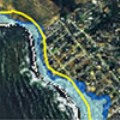
This has been a week of dire predictions about the rising sea level and its eventual consequences.
On Tuesday, scientists preparing for the Copenhagen climate talks this year said that the current IPCC working model for sea level is out of date and overly cheerful. German climate researcher Stefan Rahmstorf told the International Scientific Congress on Climate Change that even the most optimistic outlook for carbon emissions now portends at least a one-meter rise, or 3.28 feet by the end of this century. The U.N.’s 2007 report had anticipated a rise of up to two feet over the same time period.
Then today, analysts at Oakland’s Pacific Institute chimed in with a projection of California impacts from rising seas, based on a rise of 1.4 meters by 2100.
The report, which includes maps of projected inundation, projects nearly a half-million people at risk of a “100-year” flood event and loss of 41 square miles of coastal land, due to erosion.
“Critical infrastructure” in harm’s way includes highways, hospitals, schools, power and sewage treatment plants, as well as residential neighborhoods. It also includes several of the state’s busiest airports.
The report estimates that the tab for protecting that infrastructure could easily run to $14 billion. According to co-author Matt Heberger, “Communities really have to decide what it is that they value about the coast, whether that’s habitat, recreation, aesthetics, boating, shipping, all sort of things. We won’t necessarily be able to preserve all of those things at the same time. ”
The Governor has already issued an executive order requiring sea level rise to be factored into urban planning in all vulnerable regions of California. There remains an enormous planning task ahead.
Heberger sums it up thusly: “The evidence is in and we know what the impacts to the state are going to be. Now, what are we going to do about it?”
We’ll get some answers to that question on Monday’s Forum program on KQED and Sirius satellite. Listen to the archived program here.
Oceans Rising
Guests joining our discussion include Will Travis, executive director of the San Francisco Bay Conservation and Development Commission; Peter Gleick, president of the Pacific Institute, a non-partisan research institute on the environment and social equity; and Craig Miller, senior editor of KQED’s Climate Watch.
One thought on “A Rising Tide Raises All Costs”
Comments are closed.

I am all for using taxpayer dollars to create sea walls and the like to protect infrastructure and schools but I will be very upset if even one cent of my taxpayer dollars go to protecting residences on the coast. The people who own residences right on the coast took that risk (as do people who build in the floodplain) and the rest of us shouldn’t have to pay for a sea wall to protect their house.